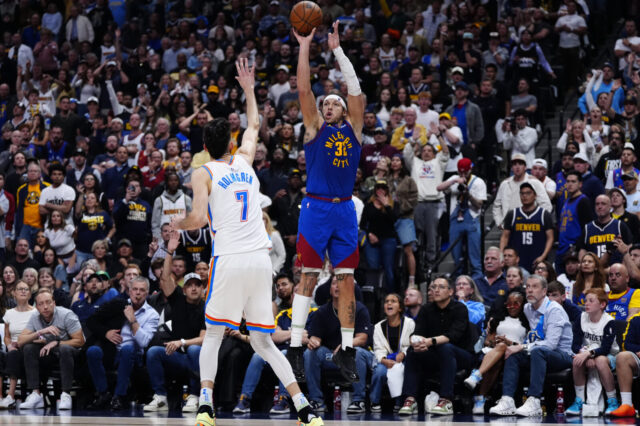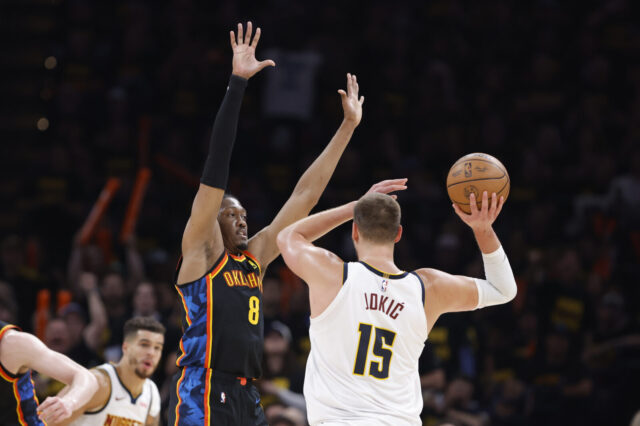Stories of the 2018-19 Denver Nuggets season cannot be told without Jamal Murray. Good or bad.
As the clock ticked away in Game 7 against the Portland Trail Blazers, the Nuggets collectively put their hopes in Murray, hoping he could pull another rabbit out of a hat. The final 3:09 of the game featured six points by the young point guard, but Denver couldn’t quite get enough stops to move onto the next round. Those six points masked a particularly poor performance from Murray in the final game scoring 17 points on 4 of 18 from the field, including making all nine of his free throw attempts. This was the Jamal Murray experience, down to the last minute of the last game.
Nobody really faults Murray for shooting poorly in Denver’s final contest. Without him, the Nuggets wouldn’t be in that position anyway. A 21-point outburst in the fourth quarter against the San Antonio Spurs in Game 2 of the first round saved Denver’s season. Back-to-back 34-point performances against the Blazers in Games 4 and 5 put the Nuggets up 3-2 in the second round, one game away from the Western Conference Finals. Nikola Jokic and Jamal Murray came to play in the second round. All Denver needed was an outlier performance from one of their other players in the final two games of the series to help seal the deal. They never got it. Not from Paul Millsap or Gary Harris. Not from anyone on the bench unit. It all fell on Jamal’s shoulders in Game 7. No wonder he had a bad showing.
I’m constantly reminding myself that, born in February of 1997, Murray is younger than me. I’m 22 years old, so I don’t get to say that about many NBA players. How many players at Murray’s young age were putting up productive numbers for a team that won 54 games? The answer is very few. You have your young stars like Kyrie Irving in the early stages of his career, Devin Booker, Luka Doncic, and Trae Young, but none of those guys were productive on a winning team. Only Magic Johnson in 1980, Kobe Bryant in 2000, and LeBron James in 2006 matched Murray’s 18.2 points, 4.8 assists, and 53.8 True Shooting % at Age 21 or younger on a team with a winning record. The circumstances for Magic and LeBron, the driving force behind winning on each of their teams, were certainly different from Kobe and Jamal. Kobe had Shaquille O’Neal, the most physically dominant player at the turn of the century. Jamal has Nikola Jokic, the most skilled playmaking big man of this era.
For Murray to carry that company though is certainly impressive. For him to make the plays he made this year is even more so.
Here’s how Murray made his impact during the 2018-19 regular season.
This content is no longer available.
Three level scoring
“Three level scorer” is a term used to designate skill level and versatility when projecting how players will perform in the NBA. Murray’s current profile suggests he is a three-level scorer, one who can make shots in the three designated areas: at the rim, in the mid range, and behind the three-point line.
Murray’s most consistent play this year was the two-man game with Jokic, either in a pick and roll or dribble hand off action, driving to his left. Out of this action, Murray generally dribbled toward the left elbow, either continuing on to the rim, executing a pass to Jokic either rolling to the rim or at the top of the key, or he would hit one of his most consistent shots, the pull-up mid range jumper.
This was a shot the defense was generally willing to give up. It’s usually an inefficient shot, but Murray maximized his efficiency from that range. Players like Kevin Durant (55.4 FG%) and CJ McCollum (51.3 FG%, R.I.P. Nuggets) were the bread winners on mid range jumpers, but Murray posted a 46.8 FG% himself, 9th out of 35 players to take at least 150 shots from that distance.
As Murray becomes even more comfortable with shooting off the dribble, he can continue to expand his range. He showed the ability to generate clean perimeter jumpers off the dribble as the playoffs wore on, an exceedingly important skill for a guard to develop. It isn’t the most efficient way to raise a team’s offensive rating, but it’s another option to have in the arsenal when teams are making an effort to take away other parts of a team’s offense.
And sometimes, you just need a basket. Murray’s ability to hit a step back jumper saved the Nuggets when the shot clock ran down at the end of games.
Example A:
Example B:
The biggest fear I have with Murray is reduced efficiency shooting at the rim this year. Among the 111 players to attempt at least 200 shots from 0-3 feet this season, the restricted area, Murray’s 58.3 FG% ranked just 96th. He was better than Damian Lillard and CJ Mccollum, who ranked 101st and 103rd respectively, so it’s not a death sentence for his efficiency. It would, however, help him in the margins. Stephen Curry posted a 64.9 FG%. Kyrie Irving posted a 63.0 FG%. Donovan Mitchell was at 61.7 FG%.
Still, this was a solid season for Murray in the scoring department. His true shooting percentage doesn’t really do him justice. As he continues to hone in his game and make small improvements on the fringes, that number is going to rise. I’d be very surprised if it doesn’t. He expanded his scoring repertoire a lot this year, and so much of the burden fell on his shoulders given the injuries and reduced offensive roles of Gary Harris and Will Barton. As he adjusts, I expect the shot to drop more frequently from every location.
Playmaking
This was another area of Murray’s game that experienced some modest improvement. From the basic statistics to some more advanced metrics, Murray’s level of passing jumped.
In 2017-18, Murray averaged 5.3 assists per 100 possessions, often ceding playmaking duties to Will Barton at the end of games. In 2018-19, that number has elevated to 7.3 assists per 100, a modest increase for a team that already features Nikola Jokic’s 11.4 assists per 100, third in the NBA. The biggest jump seems to have occurred in his chemistry with Jokic and his ability to find passing angles with rhythm, fluidity, and speed.
This is an easy pass for an elite point guard. Murray hasn’t always been able to execute that pass with rhythm though, and in Game 7 of a playoff series, he made it with the highest amount of pressure.
Murray’s 11.9 assist points created per game aren’t a super impressive number, but he averaged just 8.2 assist points created in 2017-18, a far cry from elite passing numbers. Those passes have come via added opportunities and poise to shoulder that load as a creator.
He still has improvements to make of course. The majority of his assists are generated by passing to Jokic, but Murray struggles to get others involved in the rhythm of the game, often misreading the defense when his first option (score) and second option (Jokic) are cut off.
Overall, point guards take the most time to develop. Murray isn’t a natural decision maker, but he’s learning. The pay off for when he can eventually see the entire floor will be immense, but until then, Denver’s passing options while Murray has the ball remain limited.
Defense
It’s time to really hammer home Jamal Murray’s defense. It’s bad.
Much in the way the Nuggets had the “Come to grips” moment with Nikola Jokic about him being a defensive liability after 2017-18, the Nuggets must have a conversation with Murray regarding similar issues. Both the Spurs and Blazers tracked down Murray on the defensive end and exploited his weaknesses, providing a ceiling on Denver’s ultimate future until Murray can figure things out.
The biggest issue with Murray’s defense is his inability to stay attached to his man. With as many quick and skilled guards as there are in the NBA, it’s important to maintain proper fundamentals and positioning. Murray struggled with both in the playoffs.
That’s just atrocious. Murray gave him too much room to make his move and then couldn’t adjust for the spin when it happened. Rodney Hood was the bane of Denver’s existence in the playoffs, and many of his baskets came against Murray, especially in clutch time. Against Murray, Hood shot 9/13 in the playoffs, and there was no deterrence there in any way, shape, or form.
When Murray was forced to guard the opposing team’s top guards? Much of the same result.
Remember Derrick White? Murray couldn’t handle him in Game 3 against San Antonio, so the Nuggets were forced to make a lineup and defensive assignment change in Game 4 and through the rest of the playoffs.
The Nuggets got lucky in the first round that they could adjust in that fashion. The Spurs didn’t have a third guard or wing that could really punish Denver. The same wasn’t true against Portland, as Hood punished Murray and the Nuggets for six straight games before getting hurt in Game 7.
If Murray is to take the next step as a player, it can’t just be on offense. Defensively, he needs to become playable against at least one type of offensive scorer. Whether that’s bodying up bigger and stronger players or sticking close to faster players, Murray is too important on offense to be a defensive liability. This is the point in Murray’s career where he chooses whether he wants to become an offensive only player like Lou Williams or make the star leap. Curry and Lillard were forced to improve defensively, and while neither are great now, they can perform within the team construct. Jokic is a limited defender. Paul Millsap is 34. The Nuggets don’t have a 6’8 player on their roster to take away big wings. The best way for Murray to grow going forward: defend.
What does the future hold?
Coming off of the third year of a rookie scale contract, Murray is eligible for an extension during this offseason around October. Very few players in the 2016 draft class are more deserving of a lucrative contract than Murray, and I posited in my mailbag on Friday that Murray and the Nuggets would do well to agree on a five-year $100 million extension.
$100 million is the best of both worlds for Murray and the Nuggets. Jokic is Denver’s max player, and while Murray hasn’t proven himself to be at that level of trust yet, he has earned the right to be Denver’s second highest paid player going forward. Can he continue to improve, to make up for deficiencies in some areas while maximizing his best skills? What of his three-point shot? Can he improve to a 40% shooter from behind the arc or close to it? That would go a long way in helping Denver solve its shooting woes when the going gets tough.
Moreover, can Murray be the second best player on a championship team? My gut says no, but it’s worth taking the risk. Millsap was Denver’s second best player this past year based on his ability to anchor Denver’s defense. Murray does have the ability to become that guy though. It may not happen this offseason, but something seemed to click offensively in the playoffs for the 22-year-old. He wasn’t perfect, but he improved as the games went on, and the more playoff experience he accumulates, the more likely he’s ready to handle a defense gearing up for him in the future.
I have confidence in Jamal Murray. He has his warts, but you take the good with the bad if the good can be so great. That’s the Jamal Murray experience.


